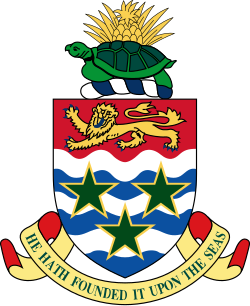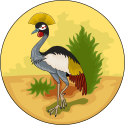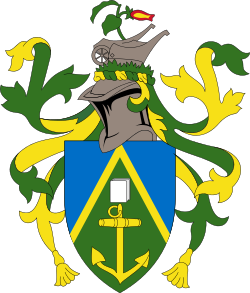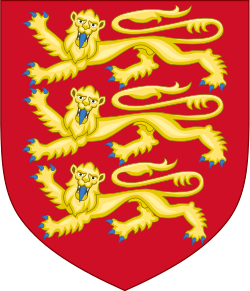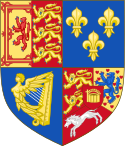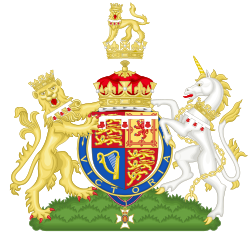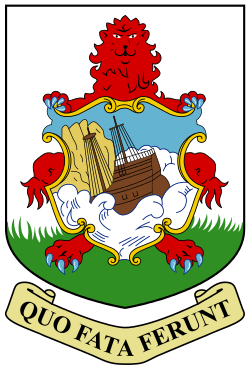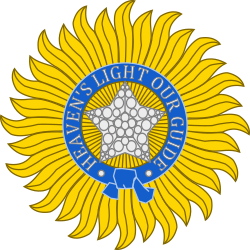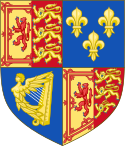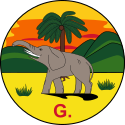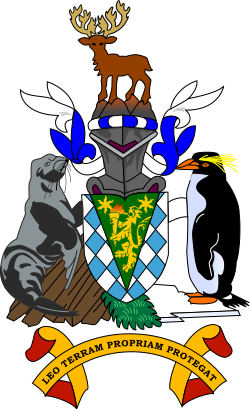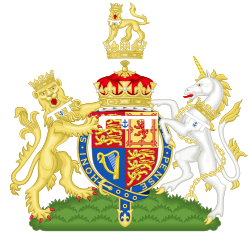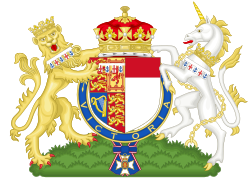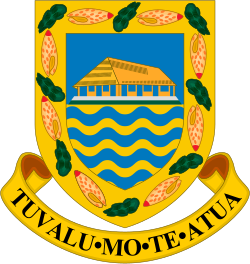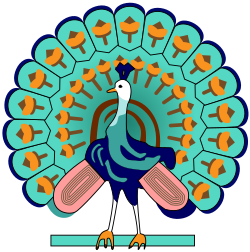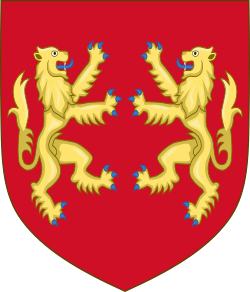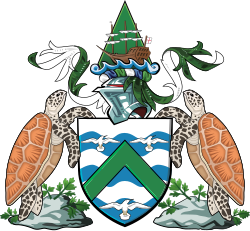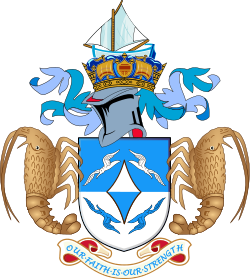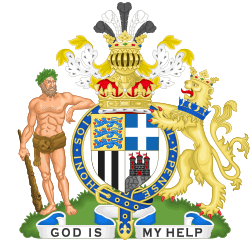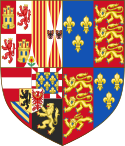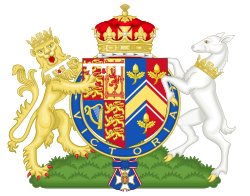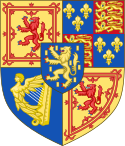Liste der britischen Wappen
Dies ist eine Liste der britischen Wappen, d. h. aller Wappen des Vereinigten Königreichs, der Britischen Überseegebiete und anderer Gebiete.
Wappen des Vereinigten Königreichs
| Flagge | Datum | Funktion/Landesteil |
|---|---|---|
| 1837– | Wappen des Vereinigten Königreichs, Vereinigtes Königreich |
Wappen der Landesteile des Vereinigten Königreichs
| Flagge | Datum | Funktion/Landesteil |
|---|---|---|
 | 1198– | Wappen Englands |
 | 1707– | Wappen Schottlands, Schottland |
| 2008– | Wappen von Wales, Wales | |
 | 1924– | Wappen Nordirlands, Nordirland |
Wappen der Kronbesitzungen der britischen Krone
| Flagge | Datum | Funktion/Landesteil |
|---|---|---|
 | Wappen Guernseys, Guernsey | |
 | 1907– | Wappen Jerseys, Jersey |
Guernsey
| Flagge | Datum | Funktion/Landesteil |
|---|---|---|
 | Wappen Alderneys, Alderney | |
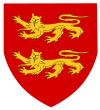 | Wappen Sarks, Sark | |
 | Wappen Herms, Herm |
Isle of Man
| Flagge | Datum | Funktion/Landesteil |
|---|---|---|
 | Wappen der Isle of Man, Isle of Man |
Wappen der Britischen Überseegebiete
| Flagge | Datum | Funktion/Überseegebiet |
|---|---|---|
 | 1980– | Wappen Anguillas, Anguilla |
 | 2012– | Wappen Ascensions, Ascension |
 | 1910– | Wappen Bermudas, Bermuda |
(c) vector version Masur, CC BY-SA 2.5 | Wappen des britischen Antarktis-Territoriums, Britisches Antarktis-Territorium | |
 | 1960– | Wappen der Britischen Jungferninseln, Britische Jungferninseln |
 | Wappen des Britischen Territoriums im Indischen Ozean, Britisches Territorium im Indischen Ozean | |
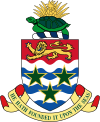 | 1958– | Wappen der Cayman Islands, Cayman Islands |
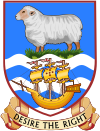 | 1948– | Wappen der Falklandinseln, Falklandinseln |
 | 1502– | Wappen Gibraltars, Gibraltar |
 | Wappen Montserrats, Montserrat | |
 | 1969– | Wappen der Pitcairninseln, Pitcairninseln |
 | 1984– | Wappen St. Helenas, St. Helena |
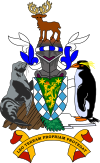 | 1985– | Wappen von Südgeorgien und den Südlichen Sandwichinseln, Südgeorgien und die Südlichen Sandwichinseln |
 | 2002– | Wappen Tristan da Cunhas, Tristan da Cunha |
 | 1965– | Wappen der Turks- und Caicosinseln, Turks- und Caicosinseln |
Königliche Wappen
| Flagge | Person/Information |
|---|---|
 | Charles, Prince of Wales außerhalb Schottlands |
 | Charles, Prince of Wales in Schottland |
 | William, Duke of Cambridge |
 | Harry, Duke of Sussex |
 | Andrew, Duke of York |
 | Beatrice of York |
 | Eugenie of York |
| Edward, Duke of Edinburgh | |
 | Anne, Princess Royal |
 | Richard, 2. Duke of Gloucester |
 | Edward, 2. Duke of Kent |
 | Michael of Kent |
 | Alexandra Ogilvy |
 | Philip, Duke of Edinburgh 1947–1949 |
 | Philip, Duke of Edinburgh 1949–2021 |
 | Camilla, Duchess of Cornwall 2005–2012 |
 | Camilla, Duchess of Cornwall 2012– |
 | Catherine, Duchess of Cambridge |
 | Meghan, Duchess of Sussex |
 | Sophie, Countess of Wessex |
 | Birgitte, Duchess of Gloucester |
 | Katharine, Duchess of Kent |
 | Marie Christine von Reibnitz |
Historische Wappen
Historische Wappen des Vereinigten Königreichs und seiner Glieder
Vereinigtes Königreich
| Flagge | Datum | Funktion/Landesteil |
|---|---|---|
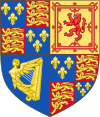 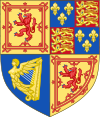 | 1603–1689 | |
 | 1649–1654 | |
 | 1654–1655 | |
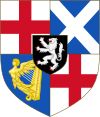 | 1655–1659 | |
 | 1659–1660 | |
  | 1603–1689 | |
  | 1689–1694 | |
 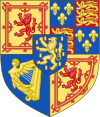 | 1694–1702 | |
  | 1702–1707 | |
 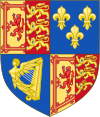 | 1707–1714 | |
  | 1714–1800 | |
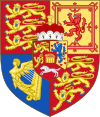  | 1801–1816 | |
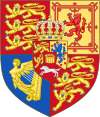 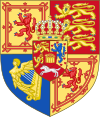 | 1816–1837 | |
 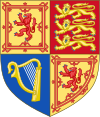 | 1837– |
England
| Flagge | Datum | Funktion/Landesteil |
|---|---|---|
 | etwa 1189 | England |
 | 1198–1340 1360–1369 | England |
 | 1340–1360 1369–1395 1399–1406 | England |
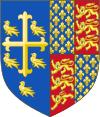 | 1395–1399 | England |
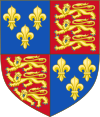 | 1406–1422 | England |
 | 1470–1471 | England |
 | 1422–1461 1471–1554 | England |
 | 1554–1558 | England |
 | 1558–1603 | England |
Schottland
| Flagge | Datum | Funktion/Landesteil |
|---|---|---|
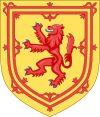 | 12. Jahrhundert–1558 1565–1603 | Schottland |
 | 1558–1559 | Schottland |
 | 1559–1560 | Schottland |
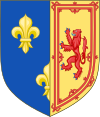 | 1560–1565 | Schottland |
Historische Wappen/Embleme des Britischen Weltreichs
Afrika
Südliches Afrika
| Wappen | Datum | Funktion | Kolonie |
|---|---|---|---|
 | 1875–1910 | Wappen der Kapkolonie | Kapkolonie (Südafrika) |
 | 1875–1907 | Wappen der Kolonie Natal | Natal (Südafrika) |
 | –1953 | Wappen Njassaland | Njassaland (Malawi) |
 | 1902–1910 | Wappen der Oranjefluss-Kolonie | Oranjefluss-Kolonie (Südafrika) |
 | 1939–1953 | Wappen Sambias | Nordrhodesien (Sambia) |
| 1924–1981 | Wappen Rhodesiens | Südrhodesien/Rhodesien (Simbabwe) | |
 | 1910–1930 | Wappen Südafrikas | Südafrika |
 | 1930–1932 | Wappen Südafrikas | Südafrika |
| 1932–2000 | Wappen Südafrikas | Südafrika | |
 | 1904–1910 | Emblem der Kolonie Transvaal | Transvaal (Südafrika) |
| 1953–1963 | Wappen der Föderation von Rhodesien und Njassaland | Föderation von Rhodesien und Njassaland (Malawi, Sambia, Simbabwe) |
Britisch-Westafrika
| Wappen | Datum | Funktion | Kolonie |
|---|---|---|---|
 | 1870–1888 | Wappen Britisch-Westafrikas | Britisch-Westafrika (Gambia, Ghana, Nigeria und Sierra Leone) |
 | 1889–1965 | Emblem Gambias | Gambia |
 | 1877–1957 | Emblem der Goldküste | Goldküste (Ghana) |
 | 1886–1906 | Emblem der Lagos-Kolonie | Lagos (Nigeria) |
 | 1900–1914 | Wappen des Protektorats Nordnigeria | Nordnigeria (Nigeria) |
 | 1900–1914 | Wappen des Protektorats Südnigeria | Südnigeria (Nigeria) |
 | 1889–1914 | Emblem Sierra Leone | Sierra Leone |
 | 1916–1961 | Emblem Sierra Leones | Sierra Leone |
Sonstiges Afrika
| Wappen | Datum | Funktion | Kolonie |
|---|---|---|---|
 | 1914–1922 | Wappen des Sultanats Ägypten | Sultanat Ägypten (Ägypten) |
 | 1922–1961 | Wappen von Britisch-Kamerun | Britisch-Kamerun (Kamerun) |
 | 1903–1968 | Wappen von Mauritius | Mauritius |
 | 1950–1960 | Wappen Somalilands | Britisch-Somaliland |
(c) Xavi Garcia, CC BY-SA 3.0 | 1874–1942 | Wappen Straits Settlements | Straits Settlements |
 | 1914–1962 | Emblem Ugandas | Uganda |
Amerika
Nord- und Mittelamerika
| Wappen | Datum | Funktion | Kolonie |
|---|---|---|---|
 | 1910– | Wappen Bermudas | Bermudas |
 | 1848–1871 | Wappen von British Columbia | British Columbia (Kanada) |
| 1862–1981 | Wappen Britisch-Honduras | Britisch-Honduras (Belize) | |
 | 1638–1860 | Wappen der Miskitoküste | Miskitoküste (Belize, Honduras) |
 | 1637– | Wappen der Kolonie Neufundland | Neufundland (Kanada) |
 | ab 1849 | Wappen von Vancouver Island | Vancouver Island (Kanada) |
Karibik
| Wappen | Datum | Funktion | Kolonie |
|---|---|---|---|
 | 1967– | Wappen von Antigua und Barbuda | Antigua und Barbuda |
| 1961– | Wappen Dominicas | Dominica | |
 | 1875–1906 | Emblem Jamaikas | Jamaika |
 | 1906–1957 | Emblem Jamaikas | Jamaika |
 | 1957–1962 | Emblem Jamaikas | Jamaika |
 | 1962 | Emblem Jamaikas | Jamaika |
 | 1967–1983 | Wappen von St. Christopher-Nevis-Anguilla | St. Christopher-Nevis-Anguilla (St. Kitts und Nevis, Anguilla) |
 | 1967– | Wappen St. Lucias | St. Lucia |
 | 1889–1958 | Wappen von Trinidad und Tobago | Trinidad und Tobago |
 | 1958–1962 | Wappen von Trinidad und Tobago | Trinidad und Tobago |
Südamerika
| Wappen | Datum | Funktion | Kolonie |
|---|---|---|---|
 | 1875–1906 | Wappen Guyanas | Britisch-Guayana (Guyana) |
 | 1906–1955 | Wappen Guyanas | Britisch-Guayana (Guyana) |
 | 1955–1966 | Wappen Guyanas | Britisch-Guayana (Guyana) |
Asien
| Wappen | Datum | Funktion | Kolonie |
|---|---|---|---|
 | 1937–1963 | Siegel von Aden | Aden |
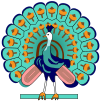 | 1948 | Wappen Burmas | Burma (Myanmar) |
| 1802–1948 | Wappen Sri Lankas | Britisch-Ceylon (Sri Lanka) | |
 | 1955 | Emblem Hongkongs | Hongkong |
 | 1876 | Emblem Hongkongs | Hongkong |
 | 1861–1947 | Wappen Indiens | Britisch-Indien (Indien) |
 | 1912–1946 | Emblem Labuans | Labuan (Malaysia) |
 | 1895–1946 | Wappen der Federated Malay States | Federated Malay States (Malaysia) |
 | 1882–1963 | Wappen Nordborneos | Nordborneo (Malaysia) |
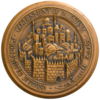 | 1920–1948 | Wappen Palästinas | Völkerbundsmandat für Palästina |
 | 1946–1963 | Wappen von Sarawak | Sarawak |
 | 1881–1905 | Badge von Britisch-Zypern | Britisch-Zypern |
 | 1905–1960 |
Europa
| Wappen | Datum | Funktion | Kolonie |
|---|---|---|---|
 | 1502– | Wappen Gibraltars | Gibraltar |
Ozeanien
| Wappen | Datum | Funktion | Kolonie |
|---|---|---|---|
 | 1976– | Wappen Tuvalus | Elliceinseln (Tuvalu) |
 | 1908– | Wappen Fidschis | Fidschi |
| 1921–1949 | Wappen des Territorium Neuguinea | Territorium Neuguinea (Papua-Neuguinea) | |
 | 1884–1888 | Wappen des Territorium Papua | Territorium Papua (Papua-Neuguinea) |
 | 1888–1906 | Wappen des Territorium Papua | Territorium Papua (Papua-Neuguinea) |
| 1906–1949 | Wappen des Territorium Papua | Territorium Papua (Papua-Neuguinea) |
Siehe auch
Weblinks
Auf dieser Seite verwendete Medien
Autor/Urheber: Sodacan, Lizenz: CC BY-SA 4.0
Badge of British Guiana (1875–1906)
Autor/Urheber: LadyofHats, Lizenz: CC0
coat of arms of Labuan from 1912 to 1946
Autor/Urheber: Sodacan, Lizenz: CC BY-SA 4.0
Badge of the New Guinea Protectorate (1884-1888)
Autor/Urheber:
- Royal_Coat_of_Arms_of_the_United_Kingdom_(Scotland).svg: Sodacan
- derivative work: Sodacan (talk)
Royal Arms of the United Kingdom of Great Britain and Northern Ireland in the style used by King Charles III from 2022 to present (as used only in Scotland).
Autor/Urheber: Samhanin, Lizenz: CC BY-SA 3.0
Coat of arms of the Commonwealth of England (1649 - 1653)
Autor/Urheber: Sodacan, Lizenz: CC BY-SA 3.0
Royal Arms of the Kingdom of Scotland from 1559 to 1560, used by Mary, Queen of Scots and Queen consort of France
Autor/Urheber: Sodacan, Lizenz: CC BY-SA 3.0
Royal Badge of Wales, as design by the Garter King of Arms in 2008 for use in all Welsh Assembly Measures.
| “ | Within a circular riband Vert fimbriated Or bearing the motto "Pleidiol Wyf I'm Gwlad" in letters the same and ensigned with a representation of the Crown proper, an escutcheon quarterly Or and Gules four lions passant guardant counterchanged armed and langued Azure, encircled by a wreath alternating of leek, thistle, clover, leek and rose. | ” |
Autor/Urheber: Will.Jackson.Vancouver, Lizenz: CC BY-SA 4.0
Photograph of the Great Seal of Colony of the Island of Vancouver and its Dependencies (c. 1849). Designed by Benjamin Wyon (1802-1858), Chief Engraver of Her Majesty's Seals. Original held at British Museum. This seal is on the classic pattern of British colonial seals from the Nineteenth Century, and combines the Royal Arms of Queen Victoria in the top third of the image with the symbols of the colony in a highly stylised shield or badge on the bottom two thirds. The principal symbols of the badge are Trident of Neptune and the Caduceus of Hermes crossed in saltire. These represent the sea and trade respectively. Above this is set a pine cone, and below is a beaver sitting on a small island surrounded by water. These represent the forest and other natural resources of the colony and perhaps also the early connection of the colony to the Hudson’s Bay Company (who also bore a beaver on their arms). The seal was only in use from the time of its creation until the union of Vancouver Island with its neighbouring colony on the mainland, British Columbia, in 1866. The united colony would, in turn, join the Canadian confederation in 1871. These symbols have, however, lived on, with a similar version of the British Royal Arms and colonial badge being featured on the Victoria Times Colonist newspaper, which originates in from the colonial period. In addition to this there is the flag of Vancouver Island, which is a British blue ensign flag with the badge of the colony in a white disk on the fly, which is still commonly flown on Vancouver Island.
Sources consulted:
Swan, Conrad. Canada: Symbols of Sovereignty, University of Toronto Press, 1977 (pp 181)Autor/Urheber: Sodacan, Lizenz: CC BY-SA 4.0
Arms of Trinidad and Tobago 1958-1962
Autor/Urheber:
- Coat_of_Arms_of_the_United_Kingdom_in_Scotland_(1801-1816).svg: Sodacan
- derivative work: Sodacan (talk)
Coat of Arms of Great Britain in Scotland from 1801 to 1816 used by King George III
Wappen von Sark
Autor/Urheber: Sodacan, Lizenz: CC BY-SA 3.0
Royal Arms of England (1689-1694)
Autor/Urheber: Sodacan, Lizenz: CC BY-SA 3.0
Coat of Arms of Camilla, Duchess of Cornwall, wife of Charles, Prince of Wales with the circlet of the Order of the Garter (awarded in 2022)
Wappen der Zentralafrikanischen Föderation
Autor/Urheber: Simi Tukidia, Lizenz: CC BY-SA 3.0
This is a vector image of the Fiji Coat of Arms re-created in Adobe Illustrator software
Autor/Urheber: Sodacan, Lizenz: CC BY-SA 3.0
Coat of Arms of Sophie, Duchess of Edinburgh
Autor/Urheber: Sodacan, Lizenz: CC BY-SA 3.0
Badge of the Uganda Protectorate (1914-1962)
Autor/Urheber:
- Coat_of_Arms_of_the_United_Kingdom_in_Scotland_(1816-1837).svg: Sodacan
- derivative work: Sodacan (talk)
Coat of Arms of Great Britain in Scotland from 1801 to 1816 used by King George III, George IV, William IV
Autor/Urheber: Thommy, Lizenz: CC0
Badge of the Sierra Leone Colony and Protectorate between 1889 and 30 July 1914.
Coat of arms of Southern Rhodesia from 1924–1964, Rhodesia from 1964–1980 and Zimbabwe from 1980–1981.
Public Seal of Mandatory Palestine
Coat of arms of the Pitcairn Islands
Autor/Urheber: Sodacan, Lizenz: CC BY-SA 3.0
Royal Arms of England (1603-1707)
Autor/Urheber: Sodacan, Lizenz: CC BY-SA 3.0
Royal Arms of England and France (1395-1399), the Coat of arms of Richard II. The Arms of England of 1340
Autor/Urheber: Sodacan, Lizenz: CC BY-SA 3.0
Royal Arms of the Kingdom of Scotland from 1560 to 1565, used by Mary, Queen of Scots and Dowager Queen of France
Autor/Urheber: Thommy, Lizenz: CC0
Badge of the Southern Nigeria Protectorate from 1 January 1900 to 1 January 1914.
Autor/Urheber: Sodacan, Lizenz: CC BY-SA 3.0
Coat of arms of HRH Princess Anne, Princess Royal (Anne Elizabeth Alice Louise; born 15 August 1950) only daughter of Queen Elizabeth II and Prince Philip the Duke of Edinburgh. The coat of arms was granted in 1962.
| “ | Quarterly, 1st and 4th Gules three lions passant guardant in pale Or armed and langued Azure (for England), 2nd quarter Or a lion rampant within a double tressure flory-counter-flory Gules (for Scotland), 3rd quarter Azure a harp Or stringed Argent (for Ireland), with over all a label of three points Argent charged on a centre point with a Heart Gules and on each of the others with a cross Gules, the lozenge ensigned by a coronet of a child of the Sovereign, the whole surrounded by the Garter, for supporters, dexter a lion rampant guardant Or crowned by the same coronet, sinister a unicorn Argent armed, crined and unguled Proper, gorged with the same coronet, attached thereto a chain affixed thereto passing between the forelegs and reflexed over the back also Or, both charged on the shoulder with a label as in the arms. | ” |
Autor/Urheber: Sodacan, Lizenz: CC BY-SA 3.0
Royal Arms of the United Kingdom of Great Britain and Ireland, Hanover, and Brunswick (1801-1816)
Autor/Urheber:
- Coat_of_Arms_of_Great_Britain_in_Scotland_(1714-1801).svg: Sodacan
- derivative work: Sodacan (talk)
Coat of Arms of Great Britain in Scotland from 1714 to 1801 used by King George I, George II, George III
Autor/Urheber: Sodacan, Lizenz: CC BY-SA 3.0
Coat of Arms of HRH Prince Henry, Duke of Sussex. (born 1984) second son of Prince Charles, Prince of Wales and Lady Diana Spencer. The coat of arms was granted in September 2002, on his 18th birthday. The three small red ‘escallop’ or sea-shell on the label alludes to the arms of his mother and the Spencer family.[1]
| “ | Quarterly, 1st and 4th Gules three lions passant guardant in pale Or armed and langued Azure (for England), 2nd quarter Or a lion rampant within a double tressure flory-counter-flory Gules (for Scotland), 3rd quarter Azure a harp Or stringed Argent (for Ireland), with over all a label of three points Argent all charged with an Escallop Gules, the escutcheon ensigned by a coronet of a child of the Sovereign (after his father's accession in 2022), for a crest on a coronet of his rank, thereon a lion statant guardant Or crowned of the same coronet charged with a label as in the arms, for supporters, dexter a lion rampant guardant Or crowned by the same coronet, sinister a unicorn Argent armed, crined and unguled Proper, gorged with the same coronet, attached thereto a chain affixed thereto passing between the forelegs and reflexed over the back also Or, both charged on the shoulder with a label as in the arms. | ” |
Autor/Urheber: Sodacan, Lizenz: CC BY-SA 3.0
Coat of arms of HRH Prince William, the Prince of Wales (born 1982) son of King Charles III and Diana, Princess of Wales. The coat of arms was granted in 2022 to him as the Heir-Apparent to the British and Commonwealth thrones.
| “ | Quarterly, 1st and 4th Gules three lions passant guardant in pale Or armed and langued Azure (for England), 2nd quarter Or a lion rampant within a double tressure flory-counter-flory Gules (for Scotland), 3rd quarter Azure a harp Or stringed Argent (for Ireland), with over all a label of three points Argent, and on an inescutcheon ensigned by the coronet of the heir-apparent, quarterly, Or and Gules four lions passant guardant counterchanged (for the Principality of Wales), the whole surrounded by the Garter; for a Crest, upon the Royal helm the coronet of his degree Proper, thereon a lion statant guardant Or crowned by a coronet of his degree Proper; Mantling Or and ermine; for Supporters, dexter a lion rampant guardant Or crowned as the Crest and charged on the shoulder with a label as in the arms, sinister a unicorn Argent armed, crined and unguled Proper, gorged with a coronet Or composed of crosses patée and fleurs de lys a chain affixed thereto passing between the forelegs and reflexed over the back also Or and charged on the shoulder with a label as in the arms; Motto ‘Ich Dien' in the compartment below the shield two badges, a plume of three ostrich feathers Argent enfiled by a royal coronet Or also with the motto ‘Ich Dien’’, and on a mount Vert, a dragon passant wings elevated Gules charged on the shoulder with a label of three points Argent. | ” |
Autor/Urheber: Sodacan, Lizenz: CC BY-SA 4.0
Badge of the Natal Colony 1905-1907
Autor/Urheber: Sodacan, Lizenz: CC BY-SA 4.0
Badge of Trinidad (1875–1889) and of Trinidad and Tobago (1889–1958).
Royal crest of the colony of British Columbia.
Autor/Urheber: Sodacan, Lizenz: CC BY-SA 3.0
Coat of Arms of HRH Prince Edward, Duke of Edinburgh. (born 1964) third son of Queen Elizabeth II and Prince Philip the Duke of Edinburgh. The coat of arms was granted in 1983.
| “ | Quarterly, 1st and 4th Gules three lions passant guardant in pale Or armed and langued Azure (for England), 2nd quarter Or a lion rampant within a double tressure flory-counter-flory Gules (for Scotland), 3rd quarter Azure a harp Or stringed Argent (for Ireland), with over all a label of three points Argent the central point charged with an Tudor rose, the escutcheon ensigned by a coronet of a child of the Sovereign, the whole surrounded by the Garter, for a crest on a coronet of his rank, thereon a lion statant guardant Or crowned of the same coronet charged with a label as in the arms, for supporters, dexter a lion rampant guardant Or crowned by the same coronet, sinister a unicorn Argent armed, crined and unguled Proper, gorged with the same coronet, attached thereto a chain affixed thereto passing between the forelegs and reflexed over the back also Or, both charged on the shoulder with a label as in the arms. | ” |
Autor/Urheber: Sodacan, Lizenz: CC BY-SA 4.0
Badge of British Guiana (1906–1955)
Autor/Urheber: Diese Datei enthält Elemente, die von folgender Datei entnommen oder adaptiert wurden:, Lizenz: CC BY-SA 4.0
An SVG image of the coat of arms of the Orange River Colony
Coat of arms of the Portuguese period in Ceylon. Later reused in the early stages of British rule in Ceylon. These arms were also used by the Dominion of Ceylon until 1954.
Wappen Bermudas
Autor/Urheber: Sodacan, Lizenz: CC BY-SA 3.0
Coat of Arms of HRH Princess Beatrice of York. (born 1988) first daughter of Prince Andrew, Duke of York and Sarah Ferguson, Duchess of York. The coat of arms was granted in July 2006, on her 18th birthday. The three small bees on the label alludes to the arms of her mother Sarah. The appearance of the bees thrice is also a canting (heraldic punning) on her name: Beatrice.
| “ | Quarterly, 1st and 4th Gules three lions passant guardant in pale Or armed and langued Azure (for England), 2nd quarter Or a lion rampant within a double tressure flory-counter-flory Gules (for Scotland), 3rd quarter Azure a harp Or stringed Argent (for Ireland), with over all a label of five points Argent the first, third and fifth points charged with a Bee volant proper, the lozenge ensigned by a coronet of a grandchild of the Sovereign, for supporters, dexter a lion rampant guardant Or crowned by the same coronet, sinister a unicorn Argent armed, crined and unguled Proper, gorged with the same coronet, attached thereto a chain affixed thereto passing between the forelegs and reflexed over the back also Or, both charged on the shoulder with a label as in the arms. | ” |
Autor/Urheber: Yashveer Poonit, Lizenz: CC BY-SA 3.0
The armorial ensigns and supporters of Mauritius are described as:
(a) for arms-
- Quarterly azure and or.
- In the first quarter a lymphad or.
- In the second, 3 palm trees vert.
- In the third, a key in pale the wards downwards gules.
- In the issuant, from the base a pile, and in chief a mullet argent.
(b) for the supporters-
- On the dexter side, a dodo per bend sinister embattled gules and argent, and
- On the sinister side, a sambur deer per bend embattled argent and gules, each supporting a sugar cane erect proper,
Autor/Urheber: Thommy, Lizenz: CC0
Badge of the colonial British West Africa Settlements between 1870 and 28 November 1888.
The Star for the Order for the India, with golden centre! Not perfectly, aligned by hands! A version of many silver centres are at Image:Star-of-India-silver-centre.svg.svg. It would be nice if they were notified where this image was used--it took them a lot of time to make the same picture. Otherwise, this version had 16 large rays including with 16 small rays. The WP article specifies 26 of each.
Autor/Urheber: Sodacan, Lizenz: CC BY-SA 3.0
Coat of arms of Marie Christine von Reibnitz, Princess Michael of Kent.
Autor/Urheber: Sodacan, Lizenz: CC BY-SA 4.0
Badge of the Colony of Hong Kong 1955
Autor/Urheber: Colohisto, Lizenz: CC0
The coat of arms of Sierra Leone when it was a British colony, used from 1914 to 1960.
Autor/Urheber: Tobias Jakobs, Lizenz: CC0
The coat of arms of the British Virgin Islands.
Autor/Urheber: FOX 52, Lizenz: CC BY-SA 4.0
Full Arms of British Honduras
Autor/Urheber:
- Coat_of_Arms_of_Great_Britain_in_Scotland_(1707-1714).svg: Sodacan
- derivative work: Sodacan (talk)
Coat of Arms of Scotland from 1707 to 1714 used by Queen of Scots Anne
Badge of North Borneo (1902–1946).
Autor/Urheber:
- Coat_of_Arms_of_the_Commonwealth_of_England,_Scotland_and_Ireland.svg: Sodacan
- derivative work: Sodacan (talk)
Coat of Arms of the Commonwealth of England from around 1653 to 1660
Coat of arms from Antigua and Barbuda, retraced to SVG
Autor/Urheber: Thommy, Lizenz: CC0
Badge of the Gambia Colony and Protectorate between 1889 and 18 February 1965.
Autor/Urheber: Sodacan, Lizenz: CC BY-SA 4.0
Badge of British Somaliland (1950–1952).
Autor/Urheber: Sodacan, Lizenz: CC BY-SA 4.0
Badge of the Transvaal Colony (1904–1910).
Autor/Urheber: Demidow, Lizenz: CC BY-SA 3.0
Wappen des Britischen Territoriums im Indischen Ozean.
Coat of arms of the Bailiwick of Guernsey. Arms of King Edward I (Plantaganet), surmounted by a sprig.
Autor/Urheber: , Lizenz: CC BY-SA 3.0
Quarterly, 1st and 4th Argent a cross Gules (England), 2nd Azure a saltire Argent (Scotland), 3rd Azure an ancient harp Or (Ireland), overall on an inescutcheon Sable a rampant lion Argent armed and langued Gules (Cromwell).
Autor/Urheber: Sodacan, Lizenz: CC BY-SA 3.0
Coat of Arms of HRH Princess Alexandra, The Honourable Lady Ogilvy. (born 1936) only daughter of Prince George, Duke of Kent (fourth son of King George V) and Princess Marina of Greece and Denmark. The coat of arms was granted in 1961.
| “ | Quarterly, 1st and 4th Gules three lions passant guardant in pale Or armed and langued Azure (for England), 2nd quarter Or a lion rampant within a double tressure flory-counter-flory Gules (for Scotland), 3rd quarter Azure a harp Or stringed Argent (for Ireland), with over all a label of five points Argent, the first and fifth points bear a heart Gules, the second and fourth points bear an anchor Azure, and the third point bears a cross Gules, the lozenge ensigned by a coronet of a grandchild of the Sovereign, the whole surrounded by the Garter, for supporters, dexter a lion rampant guardant Or crowned by the same coronet, sinister a unicorn Argent armed, crined and unguled Proper, gorged with the same coronet, attached thereto a chain affixed thereto passing between the forelegs and reflexed over the back also Or, both charged on the shoulder with a label as in the arms. | ” |
Coat of arms of South Georgia and the South Sandwich Islands
Autor/Urheber: Sodacan, Lizenz: CC BY-SA 3.0
Coat of Arms of HRH Prince Edward, Duke of Kent. (born 1935) first son of Prince George, Duke of Kent (fourth son of King George V) and Princess Marina of Greece and Denmark. The coat of arms was granted in 1948.
| “ | Quarterly, 1st and 4th Gules three lions passant guardant in pale Or armed and langued Azure (for England), 2nd quarter Or a lion rampant within a double tressure flory-counter-flory Gules (for Scotland), 3rd quarter Azure a harp Or stringed Argent (for Ireland), with over all a label of five points Argent, the first, third and fifth points charged with a anchor Azure, and the second and fourth points with a cross Gules, the escutcheon ensigned by a coronet of a grandchild of the Sovereign, the whole surrounded by the Garter, for a crest on a coronet of his rank, thereon a lion statant guardant Or crowned of the same coronet charged with a label as in the arms, for supporters, dexter a lion rampant guardant Or crowned by the same coronet, sinister a unicorn Argent armed, crined and unguled Proper, gorged with the same coronet, attached thereto a chain affixed thereto passing between the forelegs and reflexed over the back also Or, both charged on the shoulder with a label as in the arms. | ” |
Autor/Urheber: Di (they-them), Lizenz: CC BY-SA 4.0
Coat of arms of Saint Helena
Badge of the Aden Colony
Autor/Urheber: Sodacan, Lizenz: CC BY-SA 3.0
Coat of Arms of Philip Mountbatten (born 1921) granted in 1947 to Prince Philip of Greece and Denmark (Sir Philip Mountbatten). The coat of arms was considered 'unsatisfactory' and was replaced by a new one granted in 1949. In 1947 the Prince was made Duke of Edinburgh, Earl of Merioneth and Baron Greenwich by King George VI, he later married HRH Princess Elizabeth, the Heiress Presumptive to the British and Commonwealth thrones. The coat of arms represents his lineage as a Prince of Greece and Denmark on his paternal side and his descent from Queen Victoria, the Grand Dukes of Hesse, and the Battenberg (or Mountbatten) family on his maternal side.
| “ | Azure a cross Argent (Greece) surmounted by the inescutcheon of the Royal arms of Denmark as borne by Christian IX (Denmark), and over all in the first quarter an inescutcheon of the arms of Princess Alice, Grand Duchess of Hesse (daughter of Queen Victoria), the whole surrounded by the Garter; for a crest, upon a coronet of a son of the sovereign Proper, the royal helm Or, upon which issuant from a ducal coronet Or, a plume of five ostrich feathers alternately Sable and Argent (Battenberg); Mantling Or and ermine; for Supporters, sinister, a representation of Hercules girt about the loins with a lion skin, crowned with a chaplet of oak leaves, holding in the dexter hand a club Proper (Greece and Denmark), dexter, a lion queue fourchée ducally crowned Or (Grand Duchy of Hesse) and gorged with a naval coronet Azure; Motto ’God Is My Help’. | ” |
Autor/Urheber: Sodacan, Lizenz: CC BY-SA 3.0
Coat of Arms of HRH Prince Andrew, Duke of York. (born 1960) second son of Queen Elizabeth II and Prince Philip the Duke of Edinburgh. The coat of arms was granted in 1963. The label of three points, with the central point charged with an anchor; was previously borne by his grandfather King George VI ('Bertie', also named Duke of York) and King George V (also Duke of York).
| “ | Quarterly, 1st and 4th Gules three lions passant guardant in pale Or armed and langued Azure (for England), 2nd quarter Or a lion rampant within a double tressure flory-counter-flory Gules (for Scotland), 3rd quarter Azure a harp Or stringed Argent (for Ireland), with over all a label of three points Argent the central point charged with an Anchor Azure, the escutcheon ensigned by a coronet of a child of the Sovereign, the whole surrounded by the Garter, for a crest on a coronet of his rank, thereon a lion statant guardant Or crowned of the same coronet charged with a label as in the arms, for supporters, dexter a lion rampant guardant Or crowned by the same coronet, sinister a unicorn Argent armed, crined and unguled Proper, gorged with the same coronet, attached thereto a chain affixed thereto passing between the forelegs and reflexed over the back also Or, both charged on the shoulder with a label as in the arms. | ” |
Coat of arms of South Africa (1910–1930)
Autor/Urheber: Sodacan, Lizenz: CC BY-SA 3.0
Coat of arms of HRH Prince William, Duke of Cambridge from 2011 to 2022. Created when he was bestowed the title Duke of Cambridge. Disused when he became Duke of Cornwall and Duke of Rothesay upon his father's accession to the throne on 8 September 2022. Blazon:
| “ | Quarterly, 1st and 4th Gules three lions passant guardant in pale Or armed and langued Azure (for England), 2nd quarter Or a lion rampant within a double tressure flory-counter-flory Gules (for Scotland), 3rd quarter Azure a harp Or stringed Argent (for Ireland), with over all a label of three points Argent the central point charged with an Escallop Gules, the escutcheon ensigned by a coronet of a child of the Heir-apparent, the whole surrounded by the Garter, for a crest on a coronet of his rank, thereon a lion statant guardant Or crowned of the same coronet charged with a label as in the arms, for supporters, dexter a lion rampant guardant Or crowned by the same coronet, sinister a unicorn Argent armed, crined and unguled Proper, gorged with the same coronet, attached thereto a chain affixed thereto passing between the forelegs and reflexed over the back also Or, both charged on the shoulder with a label as in the arms. | ” |
Autor/Urheber: See File History, below, for details., Lizenz: Attribution
Coat of arms of Dominica
Coat of arms of the Isle of Man (Latin motto translates "Wherever you throw it, it will stand")
Autor/Urheber: Sodacan, Lizenz: CC BY-SA 4.0
Badge of British Guiana (1955–1966)
Autor/Urheber: Sodacan, Lizenz: CC BY-SA 3.0
Coat of Arms of Katharine, Princess Edward, Duchess of Kent
Autor/Urheber: Sodacan, Lizenz: CC BY-SA 3.0
Coat of Arms of HRH Prince Michael of Kent. (born 1942) second son of Prince George, Duke of Kent (fourth son of King George V) and Princess Marina of Greece and Denmark. The coat of arms was granted in 1962.
| “ | Quarterly, 1st and 4th Gules three lions passant guardant in pale Or armed and langued Azure (for England), 2nd quarter Or a lion rampant within a double tressure flory-counter-flory Gules (for Scotland), 3rd quarter Azure a harp Or stringed Argent (for Ireland), with over all a label of five points Argent, the first, third and fifth points bear a cross Gules, and the second and fourth points bear an anchor Azure, the escutcheon ensigned by a coronet of a grandchild of the Sovereign, the whole surrounded by the ribbon and badge of the Royal Victorian Order as Knight Grand Cross, for a crest on a coronet of his rank, thereon a lion statant guardant Or crowned of the same coronet charged with a label as in the arms, for supporters, dexter a lion rampant guardant Or crowned by the same coronet, sinister a unicorn Argent armed, crined and unguled Proper, gorged with the same coronet, attached thereto a chain affixed thereto passing between the forelegs and reflexed over the back also Or, both charged on the shoulder with a label as in the arms. | ” |
Autor/Urheber: Sodacan, Lizenz: CC BY-SA 3.0
Royal Arms of the Kingdom of Scotland from 1558 to 1559, used by Mary, Queen of Scots as Dauphine of France
Autor/Urheber: Sodacan, Lizenz: CC BY-SA 3.0
Royal Arms of the United Kingdom of Great Britain and Ireland, Hanover, and Brunswick (1816-1837)
Autor/Urheber: Fenn-O-maniC, Lizenz: CC BY-SA 3.0
Coat of Arms of Nyasaland
Autor/Urheber: Sodacan, Lizenz: CC BY-SA 4.0
Coat of arms of Meghan, Duchess of Sussex (born 1981). The wife of Prince Harry, Duke of Sussex. Meghan bears the arms of her husband impaled with her own. Thomas Woodcock, Garter King of Arms, the senior officer of the College of Arms, helped the Duchess with the design, which was approved by the Queen. Arms granted 25 May 2018. The blue background of the shield represents the Pacific Ocean off the California coast, while the two golden rays across the shield are symbolic of the sunshine of the Duchess's home state. The three quills represent communication and the power of words. Beneath the shield on the grass sits a collection of golden poppies, California's state flower, and wintersweet, which grows at Kensington Palace. The songbird with wings elevated as if flying and an open beak represents the power of communication.
| “ | Quarterly 1st and 4th Gules three lions passant guardant in pale Or armed and langed Azure (England), 2nd Or a lion rampant Gules armed and langued Azure within a double tressure flory counterflory (Scotland), 3rd Azure a harp Or stringed Argent (Ireland), the whole differenced by a label of five points Argent, the first, third and fifth points charged with an escallop Gules (Prince Harry); Impaled with a shield Azure a feather bendwise Argent quilled Or between two bendlets Or all between two like feathers Argent quilled Or (Markle). The whole ensigned with a coronet of a child of the sovereign (changed after the Duke of Sussex's father's accession in 2022). For supporters on the dexter side the lion used as a supporter by the Duke of Sussex and to the sinister a songbird Argent wings spread, unguled Or and gorged with the coronet of the Duke of Sussex. Below the shield, a mount of grass with golden poppies and wintersweet in flower. | ” |
Coat of arms of South Africa (1932–2000), vectorized version
Autor/Urheber: Thommy, Lizenz: CC0
Badge of the Lagos Colony between 1886 and 16 February 1906.
Autor/Urheber: Sodacan, Lizenz: CC BY-SA 3.0
Royal Arms of Great Britain, France and Ireland (1707-1714)
Autor/Urheber: Sodacan, Lizenz: CC BY-SA 3.0
Coat of Arms of the Duke of Rothesay
Autor/Urheber: Denelson83, Lizenz: CC BY-SA 3.0
Coat of arms of Tuvalu. Manually drawn using an image in the World Flag Database as a reference. The words "Tuvalu mo te atua" are the first line of Tuvalu's national anthem. Translated: "Tuvalu for the Almighty" (see: en:Tuvalu_mo_te_Atua)
Autor/Urheber: Sodacan, Lizenz: CC BY-SA 4.0
Badge of the Colony of Hong Kong 1876
Autor/Urheber:
- Peacock_symbol_Burma.PNG: Gryffindor
- derivative work: Fred the Oyster
Diese W3C-unbestimmte Vektorgrafik wurde mit Adobe Illustrator erstellt.
Autor/Urheber: Sodacan, Lizenz: CC BY-SA 3.0
Coat of Arms of HRH Prince Richard, Duke of Gloucester. (born 1944) second son of Prince Henry, Duke of Gloucester (third son of King George V) and Alice Montagu Douglas Scott. The coat of arms was granted in 1962.
| “ | Quarterly, 1st and 4th Gules three lions passant guardant in pale Or armed and langued Azure (for England), 2nd quarter Or a lion rampant within a double tressure flory-counter-flory Gules (for Scotland), 3rd quarter Azure a harp Or stringed Argent (for Ireland), with over all a label of five points Argent, the centre and two outer points charged with a cross Gules, and the inner points with a lion passant guardant also of Gules, the escutcheon ensigned by a coronet of a grandchild of the Sovereign, the whole surrounded by the Garter, for a crest on a coronet of his rank, thereon a lion statant guardant Or crowned of the same coronet charged with a label as in the arms, for supporters, dexter a lion rampant guardant Or crowned by the same coronet, sinister a unicorn Argent armed, crined and unguled Proper, gorged with the same coronet, attached thereto a chain affixed thereto passing between the forelegs and reflexed over the back also Or, both charged on the shoulder with a label as in the arms. | ” |
Autor/Urheber: Sodacan, Lizenz: CC BY-SA 3.0
Arms of England from 1189 - 1198
Blazon: Gules two lions combatant Or, armed and langued Azure.[réf. nécessaire]Autor/Urheber: Sodacan, Lizenz: CC BY-SA 4.0
Badge of the Territory of New Guinea
Wappen Montserrats
Wappen Nordrhodesiens
Autor/Urheber: Diafora, Lizenz: CC BY-SA 3.0
Coat of Arms of Saint Lucia
| “ | The ROSE which you see on the coat of arms tells us about England. At one time England was our “mother” country because she was in charge of our affairs. The FLEUR-DE-LIS reminds us that we belonged to France as many as seven times. The Bamboo is our national plant, two pieces form the cross of the shield. The little AFRICAN STOOL in the centre is African and reminds us of our ancestors who were shipped from Africa during the slave trade. To light us on our way, we have a TORCH which is held up high. The Saint Lucian Parrot Amazona versicolor is our national bird guards each side of the Coat of Arms. Our Motto “THE LAND, THE PEOPLE, THE LIGHT”, is printed at the bottom of the shield. | ” |
Coat of arms of Tristan da Cunha
Autor/Urheber: Sodacan, Lizenz: CC BY-SA 3.0
Coat of Arms of HRH Prince Philip, Duke of Edinburgh (born 1921, died 2021) granted in 1949 to Prince Philip of Greece and Denmark (Sir Philip Mountbatten) consort to Queen Elizabeth II of the United Kingdom of Great Britain and Northern Ireland. In 1947 the Prince was made Duke of Edinburgh, Earl of Merioneth and Baron Greenwich by King George VI. The coat of arms represents his lineage as a Prince of Greece and Denmark on his paternal side and his descent of the Mountbatten family on his maternal side.
| “ | Quarterly, First Or, semée of hearts Gules, three lions passant in pale Azure (For Denmark), Second Azure, a cross Argent (For Greece), Third Argent, two pallets Sable (For Battenberg or Mountbatten), Fourth Argent, upon a rock Proper a castle triple towered Sable, masoned Argent, windows, port, turret-caps and vanes Gules (For Edinburgh), the whole surrounded by the Garter; for a crest, upon a coronet of a son of the sovereign Proper, the royal helm Or, upon which issuant from a ducal coronet Or, a plume of five ostrich feathers alternately Sable and Argent; Mantling Or and ermine; for Supporters, dexter, a representation of Hercules girt about the loins with a lion skin, crowned with a chaplet of oak leaves, holding in the dexter hand a club Proper, sinister, a lion queue fourchée ducally crowned Or and gorged with a naval coronet Azure; Motto ’God Is My Help’. | ” |
Autor/Urheber: Sodacan, Lizenz: CC BY-SA 4.0
Coat of arms of the Cape Colony 1876-1910
Autor/Urheber: Josedar, Lizenz: CC BY-SA 4.0
Coat of arms of the Turks and Caicos Islands
Autor/Urheber: Sodacan, Lizenz: CC BY-SA 3.0
Royal Arms of England (1470-1471). Henry VI of England held claims on the French throne through both his parents but had lost the Hundred Years' War in 1453.
Autor/Urheber: Sodacan, Lizenz: CC BY-SA 3.0
Coat of Arms of Birgitte, Princess Richard, Duchess of Gloucester (1989-2024)
Coat of arms of Saint Christopher-Nevis-Anguilla from 1967 to 1983
(c) vector version Masur, CC BY-SA 2.5
Coat of arms of the British Antarctic Territory.
Autor/Urheber: Echando una mano, some elements by Sodacan, Lizenz: CC BY-SA 4.0
Coat of arms of the province of Newfoundland and Labrador (Canada)
Autor/Urheber: Sodacan, Lizenz: CC BY-SA 3.0
Royal Arms of England, Spain and France (1554-1558)
Wappen Gibraltars
Autor/Urheber: Fry1989 eh?, Lizenz: CC BY-SA 4.0
Badge of Cyprus (1905–1960).
Autor/Urheber: Sarumo74, Lizenz: CC BY 3.0
Versión vectorial de https://commons.wikimedia.org/wiki/File:Coat_of_Arms_of_the_Mosquito_Monarchy.png
Autor/Urheber: Sodacan, Lizenz: CC BY-SA 4.0
Emblem of the Territory of Papua
Autor/Urheber: Sodacan, Lizenz: CC BY-SA 4.0
Badge of British New Guinea (1888-1906)
Autor/Urheber: Sodacan, Lizenz: CC BY-SA 3.0
Coat of Arms of HRH Princess Eugenie of York. (born 1990) second daughter of Prince Andrew, Duke of York and Sarah Ferguson, Duchess of York. The coat of arms was granted in July 2008, on her 18th birthday. The three thistle heads on the label alludes to the arms of her mother Sarah.
| “ | Quarterly, 1st and 4th Gules three lions passant guardant in pale Or armed and langued Azure (for England), 2nd quarter Or a lion rampant within a double tressure flory-counter-flory Gules (for Scotland), 3rd quarter Azure a harp Or stringed Argent (for Ireland), with over all a label of five points Argent the first, third and fifth points charged with a Thistle head proper, the lozenge ensigned by a coronet of a grandchild of the Sovereign, for supporters, dexter a lion rampant guardant Or crowned by the same coronet, sinister a unicorn Argent armed, crined and unguled Proper, gorged with the same coronet, attached thereto a chain affixed thereto passing between the forelegs and reflexed over the back also Or, both charged on the shoulder with a label as in the arms. | ” |
Autor/Urheber: Sodacan, Lizenz: CC BY-SA 3.0
Coat of Arms of the Sultan of Egypt (1914 - 1922)
This is the coat of arms of former British colonies the Federated Malay States (1896-1942), the Malayan Union (1946-1948) and the Federation of Malaya (1948-1950).
Autor/Urheber: Samhanin, Lizenz: CC BY-SA 3.0
Coat of arms of the Commonwealth of England, Scotland and Ireland (1659 - 1660)
Coat of arms of the Crown Colony of Sarawak
Autor/Urheber: Thommy, Lizenz: CC0
Badge of the British Gold Coast colony (1821–1957) — used between 1877 and 6 March 1957.
Autor/Urheber: , Lizenz: CC BY-SA 3.0
Coat of Arms of Camilla, Duchess of Cornwall, wife of Charles, Prince of Wales, as designed by the College of Arms in 2005[1][2] Quarterly 1st and 4th gules three lions passant guardant in pale or armed and langed azure 2nd or a lion rampant gules armed and langued azure within a double tressure flory counterflory of the second 3rd azure a harp or stringed argent (the Royal Arms of the United Kingdom), the whole difference with a label of three points Argent; with an inescutcheon of four lions passant guardant, in gold and red, counterchanged, surmounted by the coronet of the heir (for the Principality of Wales); impaled with a shield of Azure a Boar's Head erased close Argent armed and langued Or on a Chief engrailed Argent between two Mullets Gules a Cross crosslet fitchy Sable.[2] With supporters: Dexter, a lion rampant gardant Or crowned with the coronet of the heir, differenced with a label of three points Argent; sinister: a Boar Azure armed and unguled Or langued Gules and gorged with a Coronet composed of crosses formy and fleurs-de-lys attached thereto a Chain reflexed over the back and ending in a ring all Or.[2] The whole surmounted by a coronet of the heir apparent.
- ↑ Camilla's coat of arms unveiled[1], BBC News, 17 July 2005
- ↑ a b c The Coat of Arms of HRH The Duchess of Cornwall[2], College of Arms, 17 July 2005, archived from the original on 2011-06-08
Autor/Urheber: Sodacan, Lizenz: CC BY-SA 3.0
The coat of arms of HRH Catherine, the Duchess of Cambridge. The coat of arms depict the arms of her husband (Prince William, the Duke of Cambridge) impaled with those of her father Michael Middleton.
Autor/Urheber: Vectorized by Froztbyte, Lizenz: CC BY-SA 3.0
Coat of arms of Anguilla (adopted on 13 July 2004) - Extracted from Flag of Anguilla.svg
Autor/Urheber: Fry1989 eh?, Lizenz: CC BY-SA 4.0
Badge of Cyprus (1881–1905).
Autor/Urheber: Thommy, Lizenz: CC0
Badge of the Northern Nigeria Protectorate from 1 January 1900 to 1 January 1914.











